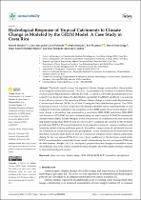| dc.description.abstract | This study aimed to assess the impacts of climate change on streamflow characteristics of five tropical catchments located in Costa Rica. An ensemble of five General Circulation Models (GCMs), namely HadGEM2-ES, CanESM2, EC-EARTH, MIROC5, MPI-ESM-LR dynamically downscaled by two Regional Climate Models (RCMs), specifically HadRM3P and RCA4, was selected to provide an overview of the impacts of different climate change scenarios under Representative Concentration Pathways (RCPs) 2.6, 4.5 and 8.5 using the 1961–1990 baseline period. The GR2M hydrological model was used to reproduce the historical monthly surface runoff patterns of each catchment. Following calibration and validation of the GRM2 model, the projected impact of climate change on streamflow was simulated for a near-future (2011–2040), mid-future (2041–2070) and far-future (2071–2100) for each catchment using the bias-corrected GCM-RCM multimodel ensemble-mean (MEM). Results anticipate wetter conditions for all catchments in the near-future and mid-future periods under RCPs 2.6 and 4.5, whereas dryer conditions are expected for the far-future period under RCP 8.5. Projected temperature trends indicate consistently warmer conditions with increasing radiative forcing and future periods. Streamflow changes across all catchments however are dominated by variations in projected precipitation. Wetter conditions for the near-future and mid-future horizons under RCPs 2.6 and 4.5 would result in higher runoff volumes, particularly during the late wet season (LWS). Conversely, dryer conditions for the far-future period under RCP8.5 would result in considerably lower runoff volumes during the early wet season (EWS) and the Mid-Summer Drought (MSD). In consequence, projected seasonal changes on streamflow across all catchments may result in more frequent flooding, droughts, and water supply shortage compared to historical hydrological regimes. | es_ES |


